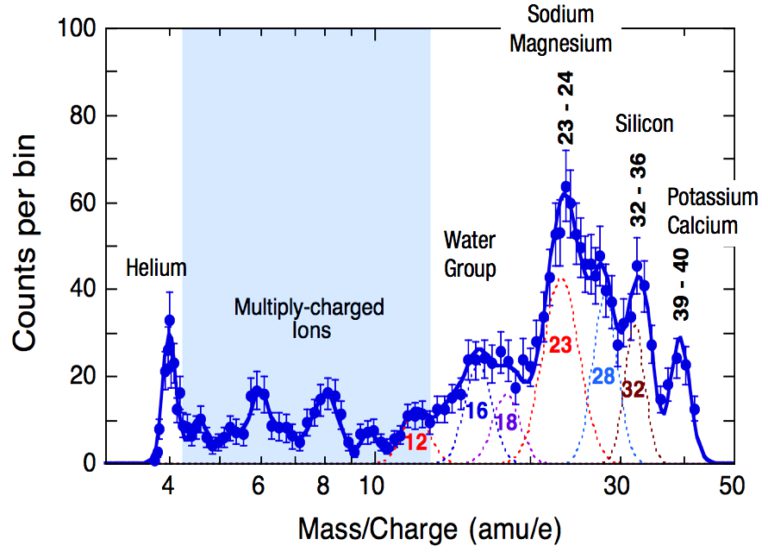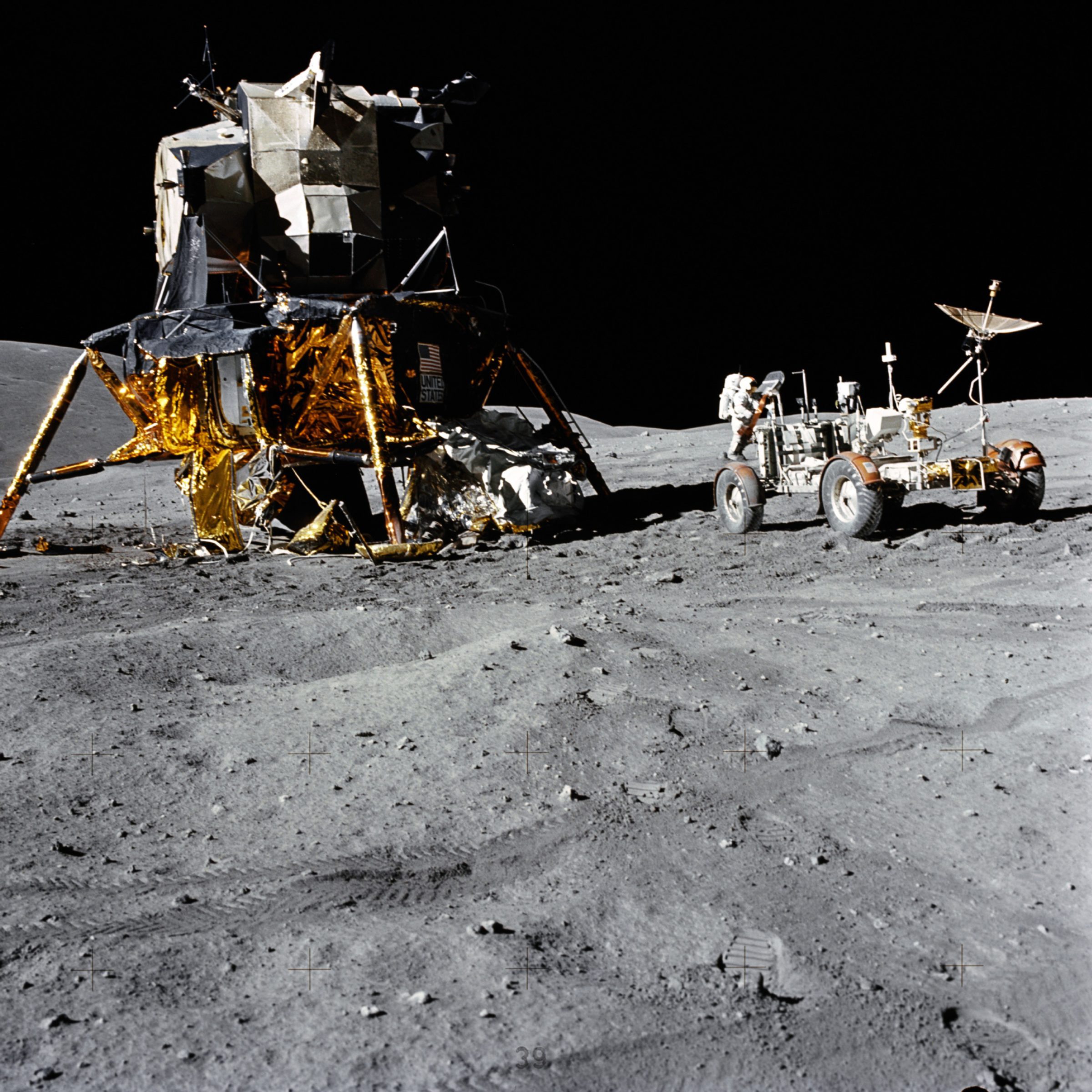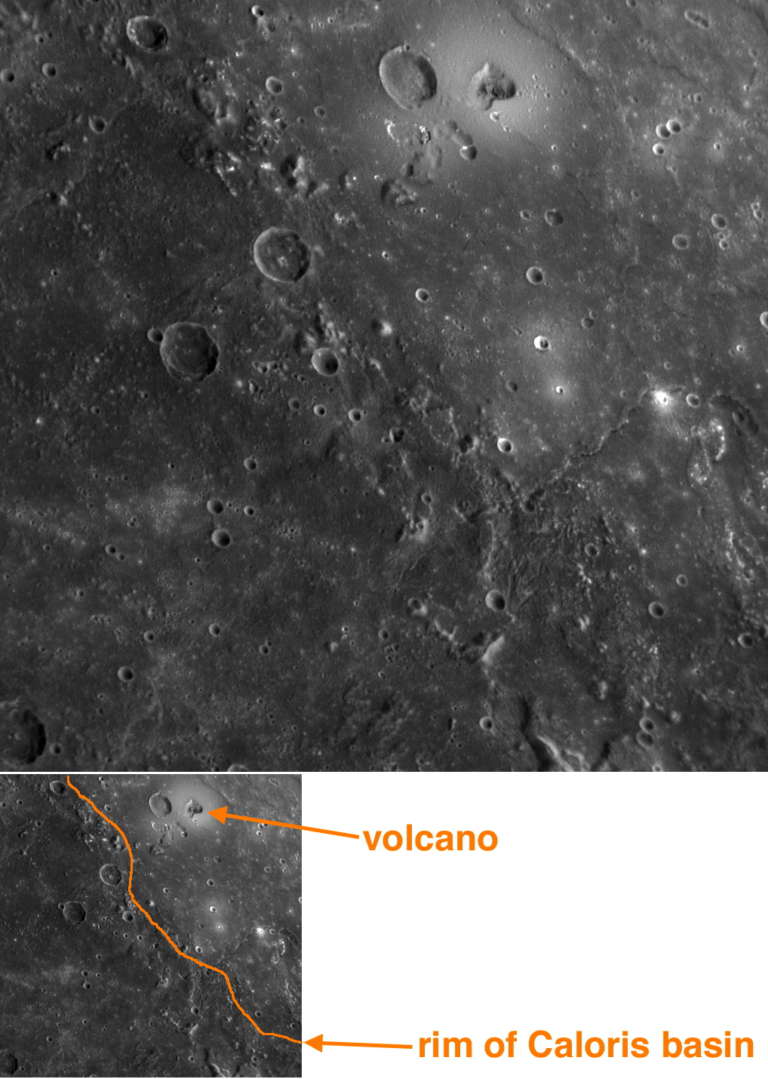Emily Lakdawalla • Jul 03, 2008
MESSENGER Scientists 'Astonished' to Find Water in Mercury's Thin Atmosphere
As MESSENGER flew past the night side of Mercury in January, its Fast Imaging Plasma Spectrometer (FIPS) scooped up ions from an atmosphere so tenuous that it's usually called an "exosphere." FIPS measured the expected amounts of ions like sodium, potassium, and calcium that had previously been detected in Mercury's exosphere, but to the science team's great surprise there was also water present, and in large amounts. "Nobody expected that. I don't know a single person that did. We were astonished, just astonished," said MESSENGER science team member Thomas Zurbuchen.
MESSENGER's flight through Mercury's "tail" This animation shows an artist's conception of Mercury's magnetosphere at the time of the MESSENGER flyby. The graphs at the bottom show observations made by the Fast Imaging Plasma Spectrometer (FIPS) instrument as the spacecraft flew past the night side of Mercury. The top plot depicts low-energy plasma -- which comes from the solar wind -- and the bottom plot shows heavy ion intensities associated with the planet.Video: NASA / U. Michigan / JHUAPL / CIW
These findings were reported today in a telephone press briefing timed to coincide with the publication of eleven papers in the journal Science. At the same briefing, scientists announced the answer to the three-decade-old question of whether volcanism was important in shaping Mercury's surface as it has been for the Moon by showing visual evidence for volcanic constructs. They also reaffirmed their earlier conclusion that Mercury has a liquid core whose motions drive a dipolar magnetic field and whose slow solidification results in surface faulting as a the whole planet shrinks. All these results came from just one flyby encounter; there are two further flybys and MESSENGER's full orbital mission yet to come.
Water Above Mercury
FIPS is an in situ measurement instrument, which scoops up ions (charged particles and molecules) from Mercury's exosphere as the spacecraft flies through it. Mercury has almost no atmosphere because of the planet's close proximity to the Sun; it is continuously blasted by energetic particles from the solar wind, and any significant atmosphere it may ever have formed was eroded away long ago. The particles that MESSENGER can find near Mercury got there as a result of the solar wind bombarding Mercury's surface, reacting chemically, and knocking off atoms or molecules, a process called chemical sputtering. In a way, then, when FIPS scoops up particles from Mercury's atmosphere, it is really tasting the chemical composition of Mercury's surface.
Unlike the MASCS instrument, which measures neutral (uncharged) atoms in Mercury's exosphere (see the previous report on MESSENGER results), FIPS measures charged particles, known as ions. FIPS doesn't detect the composition of ions directly; instead, it detects particles by the ratio of their mass to their charge. It's most common for ions to be singly charged (either positively, from the loss of one electron, or negatively, from the addition of one electron), so a peak on a FIPS spectrum usually correlates with the atomic mass of an element or simple molecule. For example, the most abundant component of Mercury's exosphere, sodium (abbreviated Na), with an atomic mass of 23, shows up in the FIPS spectrum below as a prominent peak at 23, indicating that it's present in Mercury's exosphere as a singly charged ion, Na+. In theory, that peak could also represent a doubly-charged atomic or molecular ion with mass 46, but since neutral sodium is already known to be the major constituent of Mercury's atmosphere, the match of that peak with sodium is easy, and its presence no surprise to the science team.

Magnesium (Mg+, 24), silicon (Si+, 28), molecular oxygen (O2+, 32), potassium (39), and calcium (40) are all identifiable as peaks. Although they have never before been measured as ions in Mercury's exosphere, their presence is not too surprising, because all of these are very common as the components of rocks across the solar system. But "the mass range 17 to 19 was a real surprise," Zurburchen said. "Clearly, those are water group ions. Oxygen is 16, and take two hydrogen on top and that makes 18. This is very interesting, because the temperature on the surface of Mercury can range to over 400 degrees Celsius [750 degrees Fahrenheit]. Water can't really sit there. This water is clearly there. The very first time we took a whiff of the planet, it was right there."
How could there be water on Mercury? Zurburchen listed three possibilities, which are not mutually exclusive. Firstly, it has long been theorized (but not yet proved) from Earth-based radar observations that there may be reservoirs of water ice in small areas of Mercury's poles where local topography creates permanently shadowed spots in crater walls that might trap water over the age of the solar system. Second, the water could come from comets. Third, the process of chemical sputtering could create water where none existed before from the ingredients of solar wind and Mercury rock, as Zurburchen explains.
"The solar wind is highly ionized. Those are radicals -- they want to make connections with everything that they can. Imagine a solar wind hydrogen showing up and hitting the surface. It weathers whatever the mineral is, and steals an oxygen. If you do that, you get something like OH-, for example." OH-, also known as a hydroxyl group, would produce a peak at atomic mass 17 on the FIPS spectrum. "You can do it in reverse -- an oxygen from the solar wind can steal a hydrogen. The process is called chemical sputtering."
Although all three mechanisms are plausible, it's still a surprise how much water appears in the FIPS data: about one water-related ion for every three or four sodium ions. That surprising abundance is what eliminates other possible suggestions for what could produce a FIPS peak at masses of 16, 17, and 18, Zurburchen said. "We looked at everything we could. We had weeks of discussion about this. We concluded that [water] is the most likely interpretation. Somebody may show up and say, 'well, it's a highly charged X and Y' but I can't think of anything right now. It's both peaks, the 16 and the 18. What's 18 times three? There's nothing there. We went through all these different scenarios and at the end we basically concluded that water was the most likely."
Yes, There's Volcanism
If FIPS has created a mystery, the main camera system has solved one. Geologist and imaging team member James Head explained the ancient (in space exploration terms) origin of the volcanism-versus-impact cratering debate that has dogged studies of Mercurian surface geology since the mid-1970s. "Over thirty years ago, the data returned by Mariner 10 gave us a view of the geology of less than half of Mercury. These images raised some fundamental questions about the importance of the impact processes and the volcanic processes that shape planetary surfaces. When you look up at the Earth's Moon in the night sky, it's really easy to see the difference between the dark lowland plains called maria and the bright heavily cratered highlands. In the early days of lunar exploration, Lunar Orbiter images of the maria showed flow fronts, suggesting to geologists that the dark plains were composed of lava flows. This interpretation was confirmed by Apollo 11 astronauts when they explored the surface and returned basaltic rocks typical of lava flows. Bolstered by this success, lunar geologists interpreted brighter smooth plains in the lunar highlands known as the Cayley formation also to be of volcanic origin."



Head continued: "In 1972, NASA targeted the Apollo 16 mission to land on these Cayley plains. When the Apollo 16 astronauts explored the surface, they discovered that the bright Cayley plains were not volcanic lava flows but were instead formed by ponded impact ejecta distributed by the huge impact basins like Imbrium when they formed. At about the same time, in 1974, the Mariner 10 mission began the first flybys of Mercury and discovered the gigantic Caloris impact basin and its surroundings. The surface in and around Caloris was covered with smooth plains, but their surfaces were bright like the surrounding cratered terrain, not dark like the lunar maria. Most geologists on the Mariner 10 team interpreted these bright plains on Mercury to be volcanic in origin because of their smooth surfaces and occasional lobate margins. Some lunar geologists, however, cautioned that these bright plains on Mercury could be related to ejecta from the Caloris impact event. They thought this way, of course, because of the Apollo 16 results. Thus began a debate on the volcanic origin versus an impact origin that has continued for over 30 years. This debate was prolonged by the fact that Mariner 10 images were generally of insufficient resolution to detect features that support a volcanic origin for the lunar maria, such as shield volcanoes and sinuous rilles."
The first MESSENGER images have "resolved this debate," Head says. Flyby observations included complete coverage of Caloris and adjacent areas to the west that had not been seen by Mariner 10 at high resolution and in many colors, producing stunning images. Prominent along the southern rim of Caloris are many bright orange spots. When examined more closely, the bright orange spots have several characteristics that are consistent with their identification as volcanic and not impact structures. For example, they are irregularly shaped (not circular), lack rims, and are surrounded by very smooth deposits (not fields of secondary impact craters). It also appears that the smooth deposits may have flowed into and partially buried the ejecta blankets and interiors of some craters. Still, Head was cautious about overexuberance about the volcanic interpretation. "And although we've seen conclusive evidence for volcanism, it doesn't mean that some of the plains aren't formed by impact ejecta. As we come to the next flybys and go on to orbit, we're going to be looking to trying to sort out which came from the impact sources and which came from the volcanic sources. We now have criteria to distinguish among these things."
MESSENGER's images of the surface indicate that three major forces have shaped it. Impact cratering has made craters everywhere, of every size. Volcanism has modified the surface, producing deposits that have flowed in to topographic features, smoothing them out. And as the iron core slowly solidifies deep within the planet, the whole planet shrinks (Mercury has probably lost about four kilometers, or not quite one percent of its diameter, since it formed), causing its surface to buckle and fault. Clearly, all three processes have operated simultaneously in the past. Craters are cut by faults which are, in turn, cratered; similar relationships exist between craters and volcanoes, and between faults and volcanoes. The processes may even have been interrelated, as Head explains: "The amount of volcanic activity on the surface is sometimes related to the amount of shrinkage. The less shrinkage you have, the easier it is for the lava to get out on the surface; the more shrinkage, the harder it is to do that. We really have a laboratory for the study of these kinds of relationships. We might predict that Mercury would have less lava on the surface as a function of time than other planets because of the huge amount of shrinkage. It's something we're absolutely excited about trying to document."
Let’s Go Beyond The Horizon
Every success in space exploration is the result of the community of space enthusiasts, like you, who believe it is important. You can help usher in the next great era of space exploration with your gift today.
Donate Today

 Explore Worlds
Explore Worlds Find Life
Find Life Defend Earth
Defend Earth

